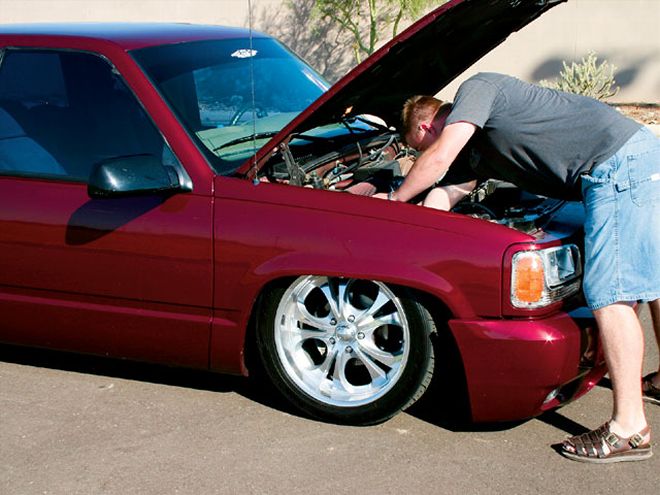
| airbags bagged Truck
It's been three months now since you put that 2/4 drop kit on your F-150, but now you really want to go lower. Seeing other trucks drag frame across the pages of your favorite magazine (this one, of course) makes you yearn for days of ripping up asphalt. You have a lot of friends who have airbags, so why not get them yourself? How hard could it be? It's just a bunch of rubber and air isn't it? Not quite. In this article, we're going to give you some of the ins and outs of airbags. We'll discuss how airbags aren't just a drop-in install process and how you do need to maintain your system to keep it working properly. We'll also take a moment and talk about how to fix your truck if something should happen to break. It's kind of like Airbags 101, if you will, but without the scary teacher and early class hours. So, sit back and take it all in. We're here to teach.
Terms You Should Knowefore you even begin to order your setup, you should probably know what the terms of the trade are. Phrases like "175-psi pressure switch" and "100 percent duty cycle" can really twist you around, if you don't know what they mean. Once you know the terms, ask yourself what you want to use your airbag setup for. Do you want to hop 2 feet in the air, or do you want to just get up and drive every day? Knowing the answers to these questions early on will help you determine what exactly you're going to need to buy and how to save money in the long run.
PSI - Pounds per square inch. You'll see psi all over your air system. Air pressure, or psi, determines the ride height of your truck. The more pressure that's in the 'bag, the higher off the ground it will be sitting. Also, the more psi in the reserve tank, the faster the air can get to your 'bags, and therefore, the quicker your truck will be getting off the ground.
CFM - Cubic feet per minute. In an air suspension, cfm is used to rate how much air a compressor will put out at a given psi. It's basically a measure of airflow. The greater the cfm a compressor is capable of delivering, the faster it will fill up your tank.
Duty Cycle - This one is tricky. The duty cycle is the amount of time an air compressor can run in a given time period. A compressor's duty cycle is determined by a complicated equation that involves two midgets and a monkey. Or it's shown by this formula: Compressor On Time / (Compressor On Time + Compressor Off Time) = Percentage. Does that make sense to you? Well, if it doesn't, don't worry about it. Here's an example: If you have a compressor with a 33 percent duty cycle, it can run for 15 minutes solid. But, then it needs to rest for 30 minutes in order to work properly. Mathematically, it is:
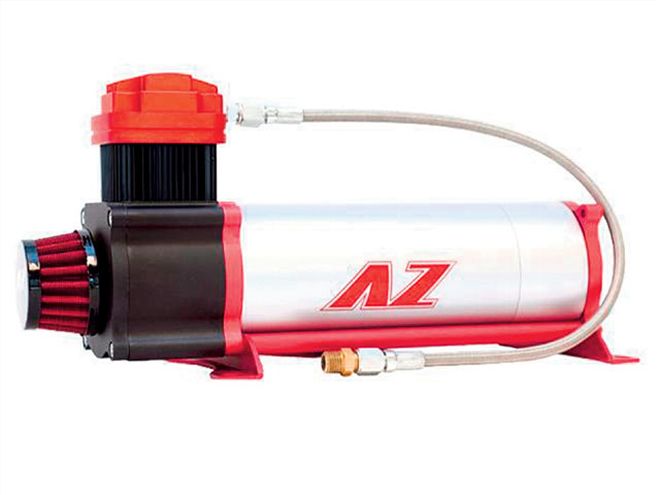
| airbags duty Cycle
15 Min / (15 Min On Time + 30 Min Off Time) = 33 Percent Duty CycleThe tricky part about duty cycle ratings is at what psi the manufacturer performs the equation at. If your compressor claims to have a 100 percent duty cycle, see at what psi it lists. If it says "100 percent duty cycle at 50 psi," then that doesn't help you get your Tacoma off the ground. The higher the psi level, the higher the compressor will perform, so a 100 percent duty cycle compressor that is rated at 100 psi is better than a 100 percent duty cycle compressor rated at 50 or 75 psi. This marks the last time you'll ever see math in an issue of Sport Truck-sorry for the interruption.
Picking Your Setup:Now that you have some information, it's time to use that knowledge to your advantage. First, ask yourself what kind of setup you want. We've broken it down to a few different concepts to make your life easier.
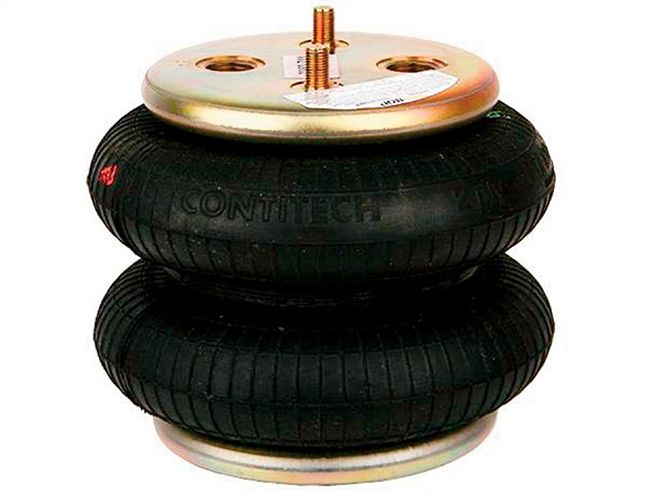
| airbags hopper
Daily Driver: You cruise your truck to work or school every day, and you want something reliable to get you from place to place. First, consider your storage options. Ten gallons of air will work well on almost any truck, but go with what you can fit. You'll want to run two compressors, as well, or an engine-driven compressor. For valves, you have a ton of options. If this is just a daily driver, and you don't care about showing off too much, you can get away with 3/8-inch orifice valves. If you just want more speed, step up to valves that contain at least 1/2-inch-diameter orifices. The larger the orifice diameter the greater the airflow through the valve and the faster your truck will lift off the ground. Be sure to also match the air-line diameter to the valve diameter for the best performance possible.
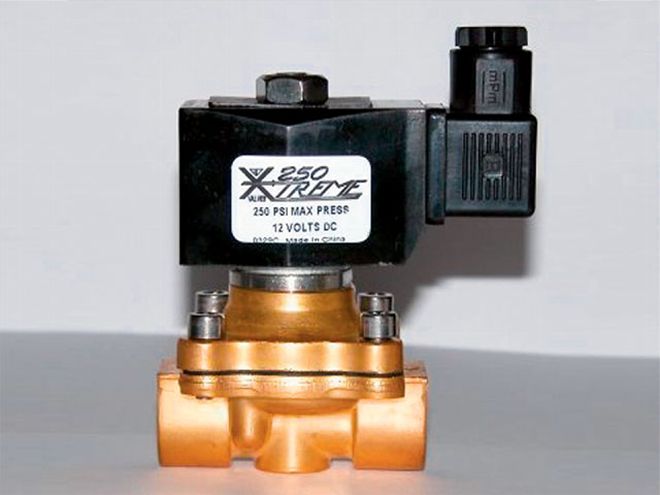
| airbags occasional Use
Hopper: Somehow laying frame just isn't cool enough for you, not unless you can launch it a foot in the air or more. Fear not, we can help you with your problem. The first issue is going to be pressure-you're going to need a lot of it at your disposal. The quickest and easiest way to go about that is with a compressed gas, like CO2 or nitrogen. Both are available in cylinders, and you'll need a regulator, too, while you're at it. Mount a tank, or three, securely in the bed, hook the regulator into your system, and get going. You're also going to want a valve that can take that kind of pressure, and the cold temps you'll get by using the gases.
| airbags valves
Tips & Tricks Sometimes, you just wish that everything came with a handbook. Not everything in the world of airbags is all candy and goodness, so we've compiled a few tips for your reading pleasure.
1. Use Loctite or Permatex, Not Teflon tapeWhen it comes to sealing up fittings during installation, don't use Teflon tape.What it does is lubricate the fitting, which makes it easier to turn. Although that's a great idea and all, the problem is you can very easily overtighten a fitting, and either break it or possibly the part you're putting it into, which may do something bad like crack the end plate of your 'bag. Not a good idea. Also, Teflon tape tends to get trapped inside the fittings and eventually the air line and valves. Valves don't like to have goo, water, or telflon tape inside them because it tends to make the valve stick open or closed.
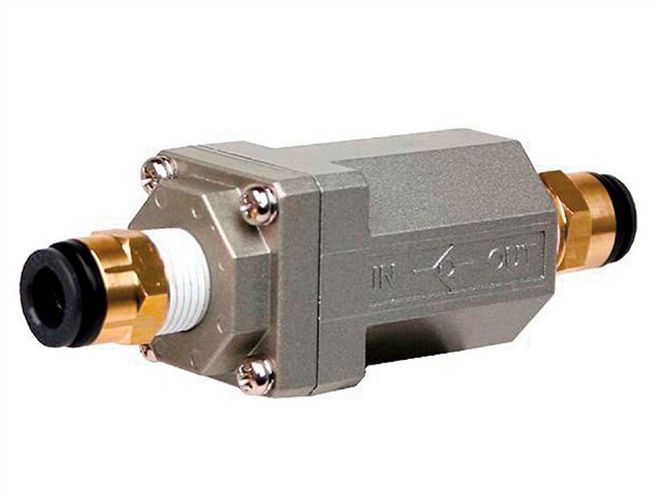
| airbags valve
2. Install Check ValvesNever heard of a check valve? Most people who put 'bags on their trucks don't have check valves in their system, and it can cause quite a few problems. What a check valve does is keep pressure flowing one direction. If you lose pressure in just one corner of your truck without one, you can dump all the pressure out of your tank, and out of every 'bag, leaving you stranded and your truck stuck laying hard on the pavement. With a check valve installed just before the valve, each corner of the truck will still stay inflated even if one loses pressure. Simply, $100 for check valves will definitely buy peace of mind.
3. Consider Your Line OptionsWhen first plumbing your setup, it's super easy to run a flexible air line. Because the line is flexible, it doesn't always stay where you put it, which can lead to problems with popping or bursting lines. One option to consider is to "hard-line" your air system. That's when you use a hard tube, instead of a soft one to connect your airbags to your valves and your air storage tanks. Copper is probably your cheapest option and the easiest to obtain, since you can find it at your local hardware store. The problem is that if it's subject to vibration, it can break. It also doesn't look that snazzy after a few weeks either. Stainless steel line is also available, but it needs special tools to bend and flare the lines. Either way you go, it may not be the cheapest option available, but it will make your system more reliable because of its resistance to abrasion and cracking.
4. Schrader ValvesInstall them. Let's say you're on your way home from a show and your front right air line to the 'bag goes out. If you have a Schrader valve installed after the fill valve, you can just drag to your local gas station and air up. It's also nice if a compressor goes out and you need a fix. Don't overlook the power of the Schrader, because it's good stuff.
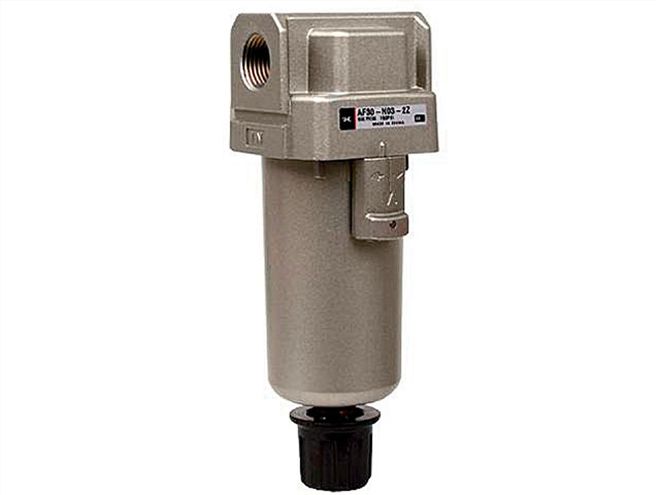
| airbags valve
5. Water TrapsWhen a compressor runs, it draws in air from the atmosphere, which contains moisture. Although the compressor produces hot air, it still contains a certain amount of moisture. When that hot air hits the tank-which is usually lower in temperature than the air-that creates condensation, which is water. Water leads to rust inside of steel air tanks or corrosion within an aluminum tank, which can jam up your valves, rust through your tanks, and screw up everything you've spent your hard-earned money on. Plus, if you live in an area where the temperature dips below freezing, you can freeze your lines, and then you're really screwed. An easy fix is to install a water trap between the compressors and the tank. What a water trap does is...trap...water. It sounds obvious, but the point is that if you put one in your system, then water isn't going to screw up your setup.
6. Check Your PowerYou're rocking out in your truck with the new stereo blasting, and all of a sudden the amp starts clipping, you loose the bass, and you sit there wondering where your Sir Mix-a-lot has gone. Compressors, like amplifiers, need power. Just like anything else, you want to be sure that your charging system can handle the load. We could ramble on about amperage draw, current ratings, and so on, but know that if your alternator isn't putting out enough power to push a 1,000-watt amplifier, then it won't likely push two high-amp air compressors either.
7. Maintain It AllEvery 3,000 miles, you change your oil, right? Well, at least once a month, you should give your air setup the once-over. Check the connections, see if your lines have any wear marks, and make sure everything is working smoothly. If you don't, you may just end up on the side of the road wondering what to do next.
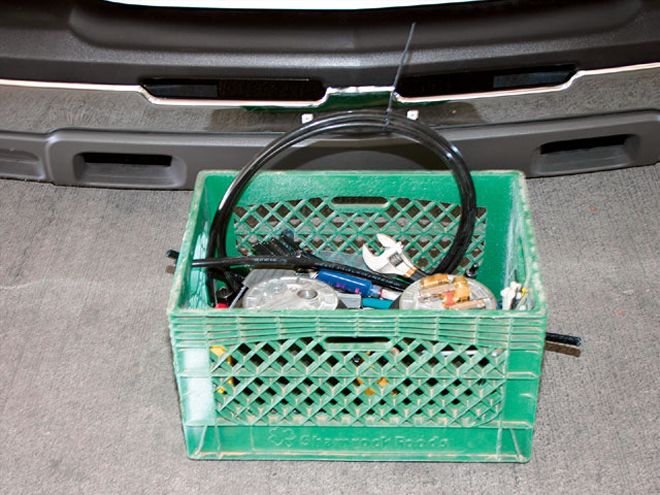
| airbags repair Kit
Roadside Repair TipsYou're stuck on the side of the road with a leaky valve. What do you do? One of the great misnomers about air suspensions is that they are maintenance-free. Install it and forget it, as it were. The fact is when you take a stock truck and put in a completely adjustable suspension, things aren't going to be as reliable as they were from the factory. As a result, it comes in handy to bring a few tools with you on the road, that way you're never stuck. Here are a few suggestions.
Adjustable Slip Wrench:Got a loose fitting? Tighten it up. Need to change a valve? Take it off. The adjustable slip wrench, commonly referred to as a Crescent wrench, is great for getting off pretty much anything you need, but in particular, fittings. Carry two wrenches with you, and you'll be able to remove your fittings easier.
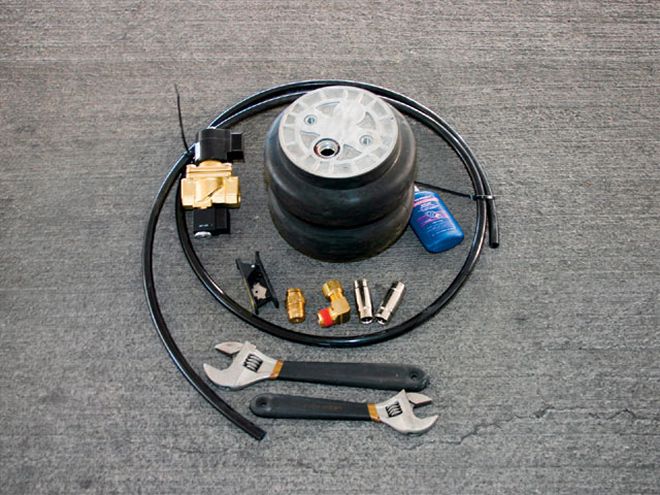
| airbags repairing Tools
Air Line: A good 80 percent or so of all airbag suspensions run a "soft" line, or a flexible air hose in the system. If you're running soft line, make sure that it's not installed anywhere near heat, like say, the exhaust system. If it is, get ready to hear the sweet sound of an air line popping. If the line is run too loose, and it rubs against a framerail, you can have the same problem. Make sure your line is installed well, and you'll keep your down time to a minimum. Bring some extra line with you, just so you can splice in a piece if need be.
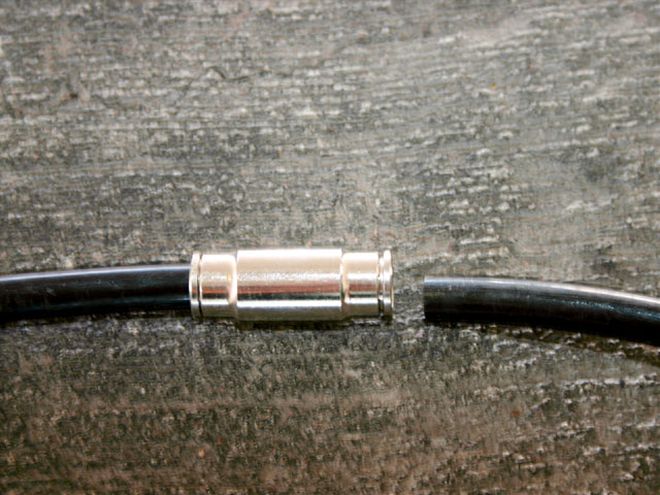
| airbags air Line
Fittings: First, carry some hose unions with you, just in case you have an air line leak. If it's a small enough leak, you may be able to get away with splicing in a union and not even replacing the line. Second, carry some other miscellaneous fittings, too. You never know when something might go wrong.
Valves: We like to carry one valve with us at all times. There are lots of times when an air suspension can get junk trapped in the valves, and that causes them to stick open. The solenoids which make the valve operate are also prone to failure after some time. Either way, having a valve to rob parts off of comes in handy.
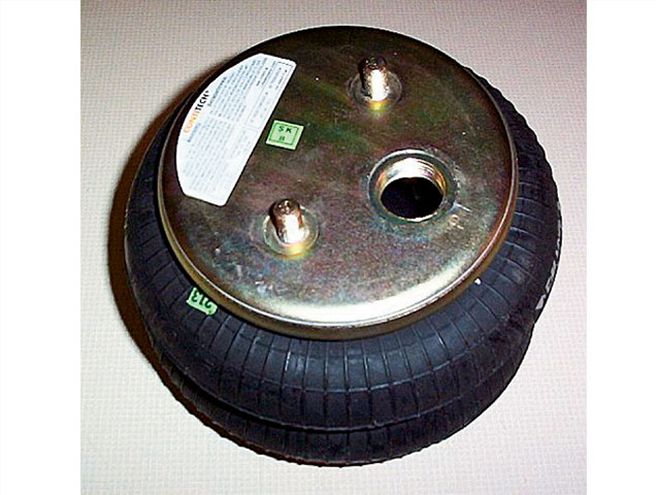
| airbags bag
'Bags: Pretty easy one to figure out here, if you blow a 'bag, you're screwed. Bring a spare 'bag and it won't be so bad.
Pressure Switch: This little guy is what turns on your compressors to fill the air tank. If it stops working, then you'll have to hot-wire your compressors and that's no fun. Some pressure switches are adjustable and some are not. Either way, bring a spare, just in case.
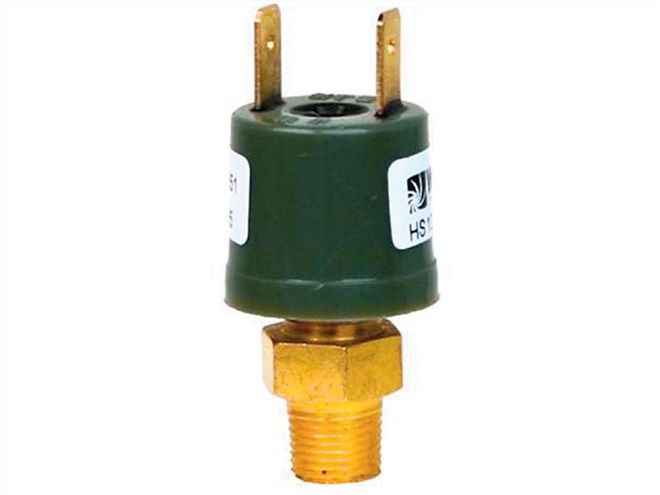
| airbags pressure Switch
Sockets & Ratchets: Sometimes, a Crescent won't cut it, but you don't want to bring the entire Craftsman catalog in your toolbox. Instead, throw only the sockets you'll need into the box, like a deep swivel socket, so if you need to get into a deep 'bag cup, you're still golden.
Butt Connectors & Crimpers: Electrical problems happen. Keep some butt connectors, ring terminals, and other miscellaneous fittings ready, and a crimper/cutter handy, too. Then, you can fix anything that'll go wrong.
There you have it, everything you need to know about air suspensions, condensed into 2,000 words or so of goodness. Follow the tips, and you'll be on your way to a trouble-free setup and thousands of miles of stress-free dragging.
 | airbags bagged Truck
It's been three months now since you put that 2/4 drop kit on your F-150, but now you really want to go lower. Seeing other trucks drag frame across the pages of your favorite magazine (this one, of course) makes you yearn for days of ripping up asphalt. You have a lot of friends who have airbags, so why not get them yourself? How hard could it be? It's just a bunch of rubber and air isn't it? Not quite. In this article, we're going to give you some of the ins and outs of airbags. We'll discuss how airbags aren't just a drop-in install process and how you do need to maintain your system to keep it working properly. We'll also take a moment and talk about how to fix your truck if something should happen to break. It's kind of like Airbags 101, if you will, but without the scary teacher and early class hours. So, sit back and take it all in. We're here to teach.
Terms You Should Know
| airbags bagged Truck
It's been three months now since you put that 2/4 drop kit on your F-150, but now you really want to go lower. Seeing other trucks drag frame across the pages of your favorite magazine (this one, of course) makes you yearn for days of ripping up asphalt. You have a lot of friends who have airbags, so why not get them yourself? How hard could it be? It's just a bunch of rubber and air isn't it? Not quite. In this article, we're going to give you some of the ins and outs of airbags. We'll discuss how airbags aren't just a drop-in install process and how you do need to maintain your system to keep it working properly. We'll also take a moment and talk about how to fix your truck if something should happen to break. It's kind of like Airbags 101, if you will, but without the scary teacher and early class hours. So, sit back and take it all in. We're here to teach.
Terms You Should Know | airbags duty Cycle
15 Min / (15 Min On Time + 30 Min Off Time) = 33 Percent Duty Cycle
| airbags duty Cycle
15 Min / (15 Min On Time + 30 Min Off Time) = 33 Percent Duty Cycle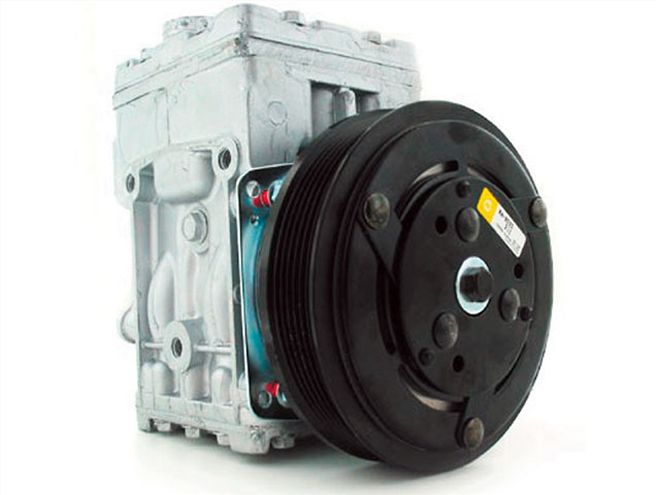
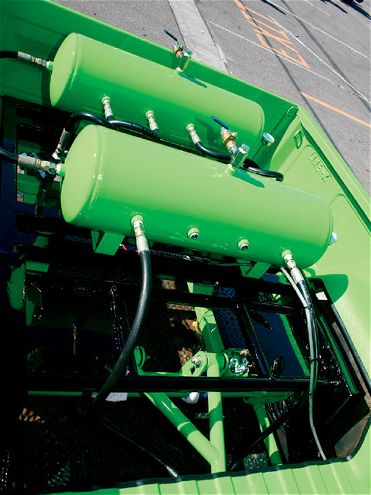
 | airbags hopper
Daily Driver: You cruise your truck to work or school every day, and you want something reliable to get you from place to place. First, consider your storage options. Ten gallons of air will work well on almost any truck, but go with what you can fit. You'll want to run two compressors, as well, or an engine-driven compressor. For valves, you have a ton of options. If this is just a daily driver, and you don't care about showing off too much, you can get away with 3/8-inch orifice valves. If you just want more speed, step up to valves that contain at least 1/2-inch-diameter orifices. The larger the orifice diameter the greater the airflow through the valve and the faster your truck will lift off the ground. Be sure to also match the air-line diameter to the valve diameter for the best performance possible.
| airbags hopper
Daily Driver: You cruise your truck to work or school every day, and you want something reliable to get you from place to place. First, consider your storage options. Ten gallons of air will work well on almost any truck, but go with what you can fit. You'll want to run two compressors, as well, or an engine-driven compressor. For valves, you have a ton of options. If this is just a daily driver, and you don't care about showing off too much, you can get away with 3/8-inch orifice valves. If you just want more speed, step up to valves that contain at least 1/2-inch-diameter orifices. The larger the orifice diameter the greater the airflow through the valve and the faster your truck will lift off the ground. Be sure to also match the air-line diameter to the valve diameter for the best performance possible.
 | airbags occasional Use
Hopper: Somehow laying frame just isn't cool enough for you, not unless you can launch it a foot in the air or more. Fear not, we can help you with your problem. The first issue is going to be pressure-you're going to need a lot of it at your disposal. The quickest and easiest way to go about that is with a compressed gas, like CO2 or nitrogen. Both are available in cylinders, and you'll need a regulator, too, while you're at it. Mount a tank, or three, securely in the bed, hook the regulator into your system, and get going. You're also going to want a valve that can take that kind of pressure, and the cold temps you'll get by using the gases.
| airbags valves
Tips & Tricks
| airbags occasional Use
Hopper: Somehow laying frame just isn't cool enough for you, not unless you can launch it a foot in the air or more. Fear not, we can help you with your problem. The first issue is going to be pressure-you're going to need a lot of it at your disposal. The quickest and easiest way to go about that is with a compressed gas, like CO2 or nitrogen. Both are available in cylinders, and you'll need a regulator, too, while you're at it. Mount a tank, or three, securely in the bed, hook the regulator into your system, and get going. You're also going to want a valve that can take that kind of pressure, and the cold temps you'll get by using the gases.
| airbags valves
Tips & Tricks | airbags valve
2. Install Check Valves
| airbags valve
2. Install Check Valves | airbags valve
5. Water Traps
| airbags valve
5. Water Traps | airbags repair Kit
Roadside Repair Tips
| airbags repair Kit
Roadside Repair Tips | airbags repairing Tools
Air Line: A good 80 percent or so of all airbag suspensions run a "soft" line, or a flexible air hose in the system. If you're running soft line, make sure that it's not installed anywhere near heat, like say, the exhaust system. If it is, get ready to hear the sweet sound of an air line popping. If the line is run too loose, and it rubs against a framerail, you can have the same problem. Make sure your line is installed well, and you'll keep your down time to a minimum. Bring some extra line with you, just so you can splice in a piece if need be.
| airbags repairing Tools
Air Line: A good 80 percent or so of all airbag suspensions run a "soft" line, or a flexible air hose in the system. If you're running soft line, make sure that it's not installed anywhere near heat, like say, the exhaust system. If it is, get ready to hear the sweet sound of an air line popping. If the line is run too loose, and it rubs against a framerail, you can have the same problem. Make sure your line is installed well, and you'll keep your down time to a minimum. Bring some extra line with you, just so you can splice in a piece if need be.
 | airbags air Line
Fittings: First, carry some hose unions with you, just in case you have an air line leak. If it's a small enough leak, you may be able to get away with splicing in a union and not even replacing the line. Second, carry some other miscellaneous fittings, too. You never know when something might go wrong.
Valves: We like to carry one valve with us at all times. There are lots of times when an air suspension can get junk trapped in the valves, and that causes them to stick open. The solenoids which make the valve operate are also prone to failure after some time. Either way, having a valve to rob parts off of comes in handy.
| airbags air Line
Fittings: First, carry some hose unions with you, just in case you have an air line leak. If it's a small enough leak, you may be able to get away with splicing in a union and not even replacing the line. Second, carry some other miscellaneous fittings, too. You never know when something might go wrong.
Valves: We like to carry one valve with us at all times. There are lots of times when an air suspension can get junk trapped in the valves, and that causes them to stick open. The solenoids which make the valve operate are also prone to failure after some time. Either way, having a valve to rob parts off of comes in handy.
 | airbags bag
'Bags: Pretty easy one to figure out here, if you blow a 'bag, you're screwed. Bring a spare 'bag and it won't be so bad.
Pressure Switch: This little guy is what turns on your compressors to fill the air tank. If it stops working, then you'll have to hot-wire your compressors and that's no fun. Some pressure switches are adjustable and some are not. Either way, bring a spare, just in case.
| airbags bag
'Bags: Pretty easy one to figure out here, if you blow a 'bag, you're screwed. Bring a spare 'bag and it won't be so bad.
Pressure Switch: This little guy is what turns on your compressors to fill the air tank. If it stops working, then you'll have to hot-wire your compressors and that's no fun. Some pressure switches are adjustable and some are not. Either way, bring a spare, just in case.
 | airbags pressure Switch
Sockets & Ratchets: Sometimes, a Crescent won't cut it, but you don't want to bring the entire Craftsman catalog in your toolbox. Instead, throw only the sockets you'll need into the box, like a deep swivel socket, so if you need to get into a deep 'bag cup, you're still golden.
Butt Connectors & Crimpers: Electrical problems happen. Keep some butt connectors, ring terminals, and other miscellaneous fittings ready, and a crimper/cutter handy, too. Then, you can fix anything that'll go wrong.
There you have it, everything you need to know about air suspensions, condensed into 2,000 words or so of goodness. Follow the tips, and you'll be on your way to a trouble-free setup and thousands of miles of stress-free dragging.
| airbags pressure Switch
Sockets & Ratchets: Sometimes, a Crescent won't cut it, but you don't want to bring the entire Craftsman catalog in your toolbox. Instead, throw only the sockets you'll need into the box, like a deep swivel socket, so if you need to get into a deep 'bag cup, you're still golden.
Butt Connectors & Crimpers: Electrical problems happen. Keep some butt connectors, ring terminals, and other miscellaneous fittings ready, and a crimper/cutter handy, too. Then, you can fix anything that'll go wrong.
There you have it, everything you need to know about air suspensions, condensed into 2,000 words or so of goodness. Follow the tips, and you'll be on your way to a trouble-free setup and thousands of miles of stress-free dragging.